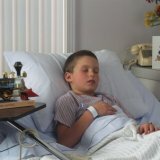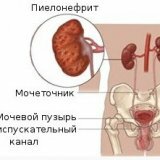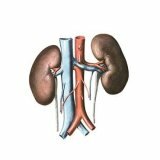Acute glomerulonephritis in children

Glomerulonephritis - bilateral inflammatory kidney disease, manifested as a rule, in the period between the fifth and twenty years of life, occurring infrequently in infants. Disease acute glomerulonephritis is more likely to affect boys. Acute glomerulonephritis in children usually develops 2-3 weeks after suffering a communicable disease( usually after an exacerbation of chronic tonsillitis, sore throat, scarlet fever, erysipelas, impetigo, rarely after pneumonia, chicken pox, measles, mumps, tuberculosis).
Acute glomerulonephritis develops in most cases after streptococcal infection. Possible and viral etiology of nephritis. Cases of acute glomerulonephritis after vaccination as recorded, medication, injections of proteins, excessive consumption of honey, snake bites and insect supercooling.
Clinical manifestations
Clinical manifestations of this disease vary and are divided into two main groups:
- extrarenal( dyspnea, palpitations, sudden headaches, loss of appetite, nausea),
- kidney( swelling in the face, waist and legs; urine brownish withLarge content of protein, erythrocytes and cylinders).
Non-adrenal manifestations, as a rule, prevail in the clinic, so they give the disease a peculiar atypical character. Also for this disease is typical triad of symptoms: edema, high blood pressure and urinary syndrome. High blood pressure( usually within 130/90 - 170/120 mm) is due to a delay in the body of fluid and sodium.
In severe cases, children suffering from acute glomerulonephritis may develop eclampsia, as a result of which they lose consciousness.
Diagnosis of the disease
If you find the first symptoms, you need to seek medical help and make a laboratory urine test. For accurate diagnosis of a sick child is carried Rehberg test, renal ultrasonography, excretory urography, and radioisotope renografii.
Treatment of acute glomerulonephritis in children
To cure glomerulonephritis in children, apply basic therapeutic methods - strict regime, nutritional therapy and medication, which defines a pediatrician, depending on the child patient. Treatment of this disease can be carried out at home and in a hospital.
In the acute period of illness the child should be put in bed and provide heat. Strict bed rest should be observed for 3-4 weeks, until diuresis is restored, edema is eliminated, blood pressure is lowered.
Drug treatment is performed using antibiotics and other medications, usually for 10 days. To eliminate swelling, the child is prescribed diuretics or phyto-tea, which will remove excess fluid from the body.
In addition, in order to cure acute nephritis in children, a specific diet is indicated. First, salt should be excluded from the diet, because it detains fluid in the body and complicates the work of the kidneys. Also, in the diet of a sick child it is necessary to minimize the content of protein products. In the future, the diet can include potatoes, oranges, watermelons and pumpkins. These fruits and vegetables will provide the child with a full-fledged diet. Fats are allowed, but not more than 70-80 g per day. The amount of consumed liquid should be reduced to 600-1000 ml per day. In addition, the diet of a sick child is administered vitamins.
Every child who has had acute glomerulonephritis should remain under the supervision of a nephrologist for at least 1 year. The control consists in the periodic surrender of the urinalysis( every 10-14 days), the measurement of blood pressure, the prevention of streptococcal infections. Within 1 year after the disease, preventative vaccinations are contraindicated for children. It is also advisable to exclude swimming, to limit physical training and to avoid hypothermia.



